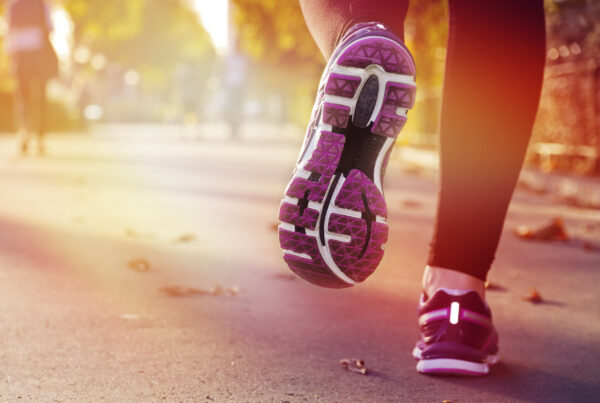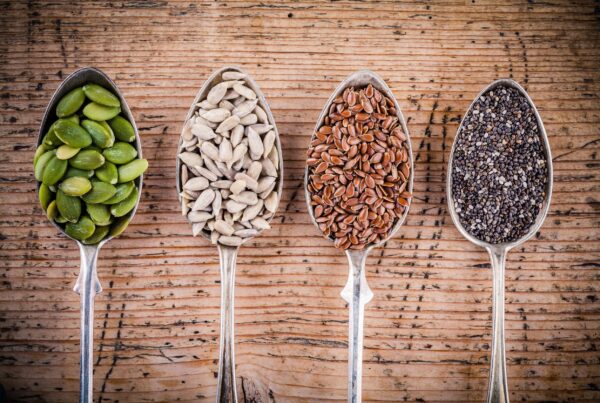”Virginia, what is your go-to snack? Do they ever include nuts? Nuts, usch as chia seeds or flax seeds, contain many important nutrients and can be easy ingredients to incorporate into your other meals. Check out this week's article to learn more!
Reading time: 9 Minutes
MWi Hack:
- Learn how to incorporate seeds into your diet
- Find out what is unique about different seeds and the associated health benefits
MWi Summary:
- Seeds are full of important minerals such as iron, calcium, magnesium, and phosphorus.
- Six seeds that are a great addition to your diet include flaxseeds, chia seeds, pumpkin seeds, sunflower seeds, hemp seeds, and sesame seeds.
- It is important to remember that while there are a lot of health benefits to seeds, they are very calorie dense, and so you should keep portion size in mind.
The 6 Best Seeds to Eat
Plant a seed. Watch it grow. Eat a seed. Reap the health benefits.
“Seeds are good sources of plant-based, healthy fats, fiber, and minerals,” says registered dietitian Kate Patton, RD. And for such a tiny package, the impacts on your body are massive. Seeds are loaded with:
- Iron – This helps you make proteins that carry oxygen-rich blood throughout your body.
- Calcium – Critical for bone health.
- Magnesium – A mineral that helps with hydration and bowel and brain health — and one we often don’t have enough of.
- Phosphorus – Important for many body functions, including repairing cells and filtering waste.
The best seeds to eat for your diet
Patton says these six seeds are a great addition to a healthy diet:
- Flaxseeds
- Chia seeds
- Pumpkin seeds
- Sunflower seeds
- Hemp seeds
- Sesame seeds
1. Why flaxseeds are good for you
Flaxseed, or flax, is the seed of the flax plant. It’s loaded with fiber, protein, and potassium. It’s also a great source of lignans. “Lignans are a polyphenol, which is a type of antioxidant. While lignans are in other plant sources, flaxseed contains 75 to 800 times more lignans than other plant foods,” says Patton.
Research has shown that the anti-inflammatory properties of lignans help prevent heart disease and cancer.
How to eat flaxseeds
Patton says flaxseeds are best-eaten ground up. “Our bodies have a hard time digesting and absorbing the nutritional benefits of the actual seed.”
Mix into hot cereals, yogurts, and smoothies or use as a substitute for some of the flour in a muffin or bread recipe.
“Flax is definitely high in fiber, so introduce it slowly, or it could affect your bowel regularity,” adds Patton. You also don’t need much — some studies showed health benefits with just 1 tablespoon of flaxseed a day.
2. Why chia seeds are good for you
Like flaxseeds, chia seeds are an excellent plant-based source of omega-3 fats, or alpha-linolenic acid. So if you’re not a big fish eater, chia seeds can help you fill the void.
“Another benefit of chia seeds is that they absorb up to 10 times the amount of water that they’re put in. So you can turn them into a gel and use it as a vegan egg substitute,” says Patton. “It can also help you stay full because of this liquid-absorption ability and its high fiber count.”
How to eat chia seeds
To make a chia gel, combine 1/4 cup of water with 1 tablespoon of chia seeds. Let them sit for about 10 minutes. This serving size would be equal to one egg if you’re using it as an egg substitute.
Patton says you can also make a vegan pudding with almond milk and chia seeds. “Again, I would start with just a tablespoon or two because of their fiber content.”
3. Why pumpkin seeds are good for you
Patton says pumpkin seeds, also known as pepitas, are a great source of lots of minerals, including zinc. “Zinc is known for helping our immunity.”
Studies have also shown that pumpkin seeds can help lower your LDL, or bad cholesterol, and prevent muscle weakness.
How to eat pumpkin seeds
Whether you grab them off the shelf or carve them right out of the pumpkin, pumpkin seeds are incredibly versatile. You can eat them shelled or unshelled (pro tip: Unshelled seeds have more fiber). Snack on them on their own or mix them into salads or vegetables for some texture.
“Roasted pumpkin seeds are also popular,” says Patton. “Simply bake them in the oven and add whatever seasonings you like. You can make them spicy or add turmeric or salt.”
It’s also important to be portion smart. Pumpkin seeds are high in fiber, calories, and fat — just one cup has 285 calories, 12 grams of fiber, and 12 grams of fat. Too many in one sitting may cause gas and bloating. And too many too often can lead to weight gain.
4. Why sunflower seeds are good for you
Sunflower seeds have a good amount of minerals, B vitamins, and antioxidants like vitamin E and selenium. “Antioxidants help reduce free radicals in your body. Free radicals are harmful chemicals that can increase our risk of diabetes, heart disease, and some types of cancer,” Patton says.
How to eat sunflower seeds
You can buy sunflower seeds with or without the shells. If they’re in shells, just bite them off and throw them away.
Choose unsalted or lightly salted to control sodium intake. “Sodium is one of those sneaky minerals. It’s easy to get too much,” says Patton. “Excess sodium contributes to high blood pressure and other health problems.”
5. Why hemp seeds are good for you
Hemp seeds, also called hemp hearts, are rich in vitamin E and potassium. They also have the most protein of all the seeds and are a great source for healthy omega-6 and omega-3 fats.
How to eat hemp seeds
Hemp seeds are bigger and crunchier than flaxseeds and chia seeds. That’s why they make a good texture addition to cereal, yogurt, and salad, says Patton. You can also try them sprinkled on rice or veggies.
6. Why sesame seeds are good for you
In addition to minerals and fiber, sesame seeds are high in selenium, an antioxidant shown to decrease the risk of chronic disease.
How to eat sesame seeds
When making Asian-inspired meals, use sesame oil or sprinkle the seeds as a garnish. They also make a great accent in salads and quinoa or rice dishes. You can also bread chicken or eggplant with crushed sesame seeds.
The potential risks of seed-eating
If you have diverticulitis, you should avoid eating seeds. Patton says they can irritate the condition because they’re packed with fiber. Seeds can also get stuck in the polyps (small growths also known as diverticula) in your colon.
“They may be small, but they’re calorie-dense, too. A little bit each day is enough to reap the benefits — or else those calories will add up.”
MWi would like to thank Cleveland Clinic for sharing their expert insights with our community through their Health Cleveland Clinic Platform. Read the original article:
https://health.clevelandclinic.org/the-6-best-seeds-to-eat/
More on the Author:
Cleveland Clinic was at the forefront of modern medicine when its founders opened it as a multi-specialty group practice in 1921. In its first century, Cleveland Clinic has introduced many medical firsts, opened facilities around the world, and is proud to be ranked among the top hospitals in the country. Now, 100 years later, the vision of the founders remains Cleveland Clinic’s mission: caring for life, researching for health, and educating those who serve.






